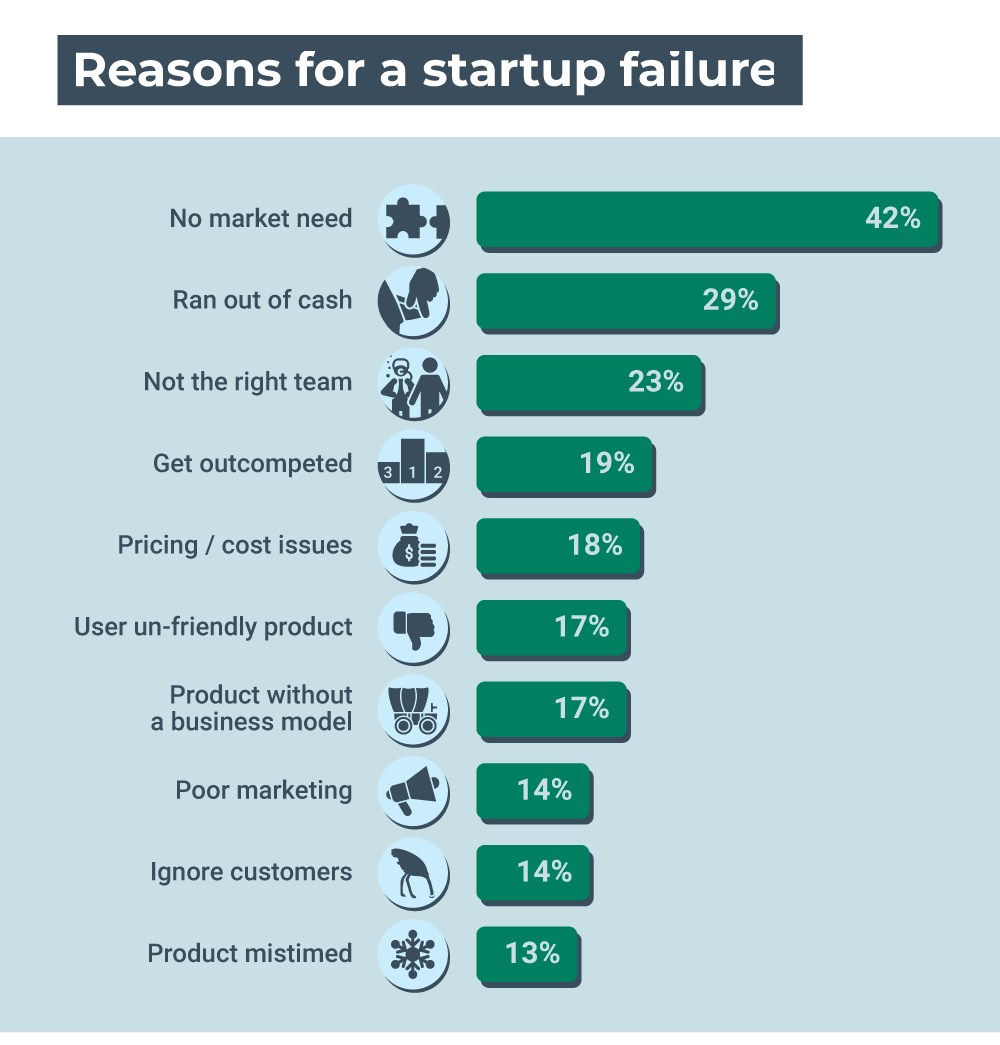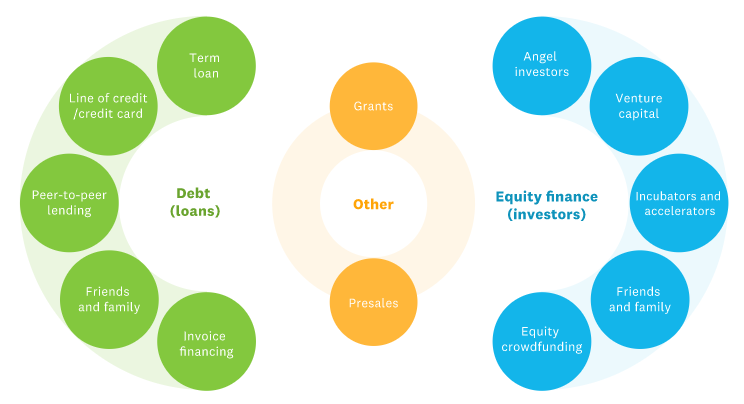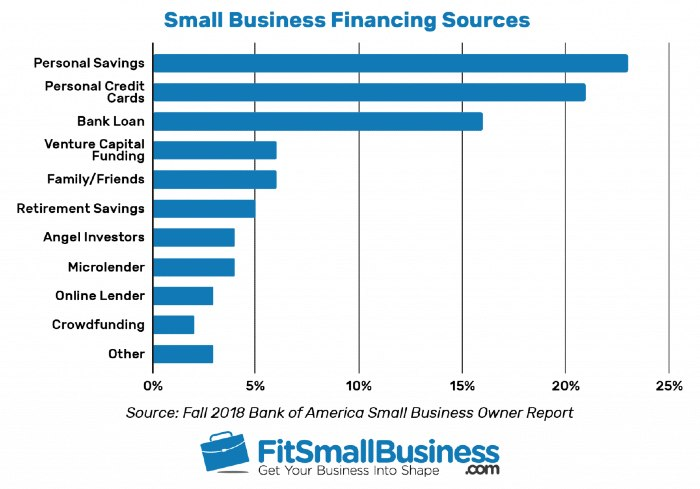Every startup or business idea needs a helping hand to get off the ground. Funds can help you to achieve all of your goals in terms of bringing a product to market, the commercialisation of your venture, the development of a website, the hiring of a team and the access needed to office space.
Most entrepreneurs look to secure outside help when it comes to covering the costs of turning an idea into reality. Fortunately, there are plenty of approaches when it comes to securing financial resources – and this ultimate guide will help to provide you with a comprehensive overview of business financing and how to strategise your path to securing your first funding.
Significance of Securing Funding
Regardless of what industry you’re aiming to enter with your startup, it can be extremely difficult to ensure your survival on a long term basis. Unsurprisingly, a lack of access to sufficient funding is among the most common reasons for failure.

(Image: RND Point)
As we can see from the chart above, running out of cash is the predominant reason for 29% of startup failures. However, the good news is that there’s no shortage of financial options available to help fund your venture.
Finding the right funding source for your business idea could make all the difference between ensuring its growth and fatally hindering your progress. Although bootstrapping in the early stages of your business could be an effective way of bypassing debt whilst raising funds and managing costs within your cash flow, it may be worth looking further afield to safeguard the development of your idea.
As much as 77% of small businesses rely on personal savings to develop their initial investment, though many entrepreneurs will require further rounds of funding to secure their startup’s long term sustainability.
When it comes to securing your first funding, there are plenty of options to explore – all with their own sets of pros and cons. Let’s take a deeper look into the methods available to entrepreneurs, but first, let’s take a quick look at the steps you can take to ensure your first steps towards securing your funding are successful ones:
Understanding Your Funding Needs
Before you can secure your first funding, it’s important to take some steps towards ensuring that your idea is capable of winning the backing of prospective investors and becoming marketable.
Although it’s inevitable that many startups won’t be capable of having lift-off, it’s possible to take some steps towards ensuring that you’re in as good a position as any to win the trust of people who may be able to support your venture financially. Those steps are:
1. Seek Out Advice From a Mentor
One problem that entrepreneurs face is proving to prospective investors that their idea is a winning one. Another problem is that it’s easy for you to believe that your business idea is great, but have you consulted an objective third party who knows their way around business management?
Finding a mentor can be a vital part of an entrepreneur’s journey, and a competent mentor will be capable of providing you with an insightful and honest perspective on your idea. Although this step may involve opening your business up to scrutiny, it’s vital that nobody risks investing some of their own savings on a bad idea.
Be sure to attend networking events and consult people in your network to connect with a mentor. There are many cities around the world that have innovation labs and mentoring programs that are designed to help turn ideas into practical business models to pitch.
By seeking out advice from a mentor, it’s possible to vet your business idea before you start to spend money on it – an essential way of safeguarding your savings.
2. Conduct Market Research
Finding your target market may be one of the most tricky steps of turning an idea into a fully-fledged business – but it’s also one of the most important.
When conducting market research, consider the following questions before getting started: Who are you targeting with your product? This question relates to the age, gender, level of education, occupation, location and buying habits of your ideal customer. Here, the more specific you can be the better in terms of marketing.
Secondly, ask who will be interested in your product? Referring back to our table from earlier, no market need for a product is the reason why 42% of businesses fail.
Be sure to conduct plenty of research before you choose to progress with your idea. You need to use a variety of sources to examine as much evidence as possible to gain the right quality of insight. This task can easily be undertaken by exploring existing and prospective business customers, collaborating with focus groups, interviewing individuals, and polling social media users. There can also be plenty of data to gather from platforms like Google Analytics.
One emerging trend that some entrepreneurs trust is to conduct research using crowdfunding. In fact, many startups have launched Kickstarters in order to test whether there’s enough consumer interest available for products. Most notably, Oculus VR managed to secure their first funding from a crowdfunding campaign – all before the business was acquired by Facebook for all of $2 billion.
3. Build a Comprehensive Business Plan
When it comes to launching a business in virtually any industry, it’s important to be clear from the outset how much money you’ll need for both your initial requirements and your initial trading.
The easiest way to evaluate all of these requirements is to formulate a comprehensive business plan. In your plan, be sure to consider all of your initial start-up costs and how they’ll impact your bottom line. These costs can include considerations like:
- Premises
- Deposits (ie rent)
- Advertising
- Insurance
- Equipment
- Initial Stocks
- Software
- Advice
- Borrowing costs
If you’re looking to pitch your idea to a venture capitalist, or are hoping to secure a bank loan, having a demonstrable business plan that leaves no stone unturned is essential in proving that you have a viable model. In showcasing the quality of your business plan, you’ll have created an accurate cash flow forecast and totalled up exactly how much money you’ll be needing to get your startup ready for action.
In the unforgiving world of business, it’s never enough to just pitch a great idea, you also need to prove that you know how to convert your idea into revenue.
Enlisting the help of an accountant with a startup business specialism is a solid start. This is because they’ll likely have worked with similar clients, making them more capable of providing actionable suggestions and pointers on the amount of money you’ll need to kick things off.
4. Take Action to Improve Your Financial Credibility
No matter where you are in your business journey, your entrepreneurial references should be favourable and your credit score should be in check.
Improving your financial credibility will help to provide you with better access to investors. This is particularly true of private equity firms, banks and seeking the help of individual investors. One good place to start is checking on your credit score. It’s possible to see what your score is in easy to follow terms via services like Experian and Equifax’s ClearScore.
There are plenty of approaches you can take as a means of improving your financial credibility. Including:
- Disassociating yourself from ex-financial partners
- Getting on the electoral roll
- Ensuring that your debts are clear
- Closing unused credit cards, store cards, debit cards and mobile contracts
- Managing your repayments in a timely manner
- Utilising a credit-building credit card
Finally, it’s also worth keeping strong relations with past investors. By building rapport with investors in your industry it can help to safeguard your reputation when it comes to seeking favours from the investing landscape.
Let’s now take a look at some of your options when it comes to securing your first funding for your startup:
Ways to Get Your First Funding
There are many approaches to accessing your first funding for your business. However, for the benefit of this guide, we’ll focus on some of the most popular and viable approaches for entrepreneurs to take in terms of funding their idea.

(Image: Xero)
As we can see from the diagram above, different forms of funding can have different ramifications for your business. Some, like loans and borrowing from friends and family, are debt-based – where you typically have to repay your funders later down the line. While others, like venture capital funding and equity crowdfunding, are equity-based, where you’ll be expected to give up a percentage of your business in return for finance.
Having a strong business plan in place can be significant particularly when it comes to equity finance because investors will be seeking to gain equity in your business that will allow them to comfortably see a return on their investment. If your business plan shows that you’re ready to grow exponentially over the coming months and years, they’ll likely be willing to part with more of their money in return for a lower percentage of equity.
With this in mind, let’s explore some key funding methods:
1. Bootstrapping
Bootstrapping doesn’t have the best of reputations among some entrepreneurs due to the slower growth rates businesses experience when compared to funding from venture capitalists or business loans, for instance. However, there are plenty of reasons why lots of business owners prefer to bootstrap their way to success.
Firstly, it’s worth considering the appeal of having little to no debt involved in getting your startup off the ground. Without the prospect of loans to pay off, entrepreneurs can rest assured that they won’t have to worry about their debts piling up over time.
Perhaps most significantly of all is that entrepreneurs that bootstrap won’t have to worry about losing full control over the management of their venture. With no investors or shareholders to answer to, business owners are free to develop their business to suit their vision. There’s also no danger of having to make compromises to appease the investors funding your growth, and no risks of losing other people’s money along the way.
However, bootstrapping is also a lot of hard work for one entrepreneur to deal with. Unless you have an exceptional amount of personal wealth, it can be very difficult to fund your own business without making significant personal sacrifices to control your finances. By bootstrapping, you’ll also have to budget your scaling process, meaning that your growth could be much slower than if an angel investor pumped all the money you need into the company in one go, for instance.
There’s also the hindrance of having no external help in the running of your startup. While full equity can be a great way of maintaining full control over your business decisions, sometimes a little external support from an expert investor can go a long way in helping your idea to take off.
With this in mind, the appeal of finding investment can’t be ignored, but bootstrapping can be excellent as an alternative that helps you to retain full control over your startup. If you’re willing to learn as your business grows, it may be worth financing your venture yourself.
2. Friends and Family
Asking friends and family for help in funding your business may seem daunting – but it can also be one of the safest ways of bankrolling your venture before seeking external funding.
The task of asking your friends and family for financial assistance tends to involve much less paperwork than venture capitalists, and their terms of repayment are generally much more laid back.
Despite the process of seeking financing from friends and family being a fairly informal one, it’s still very much worth making sure you have a business plan ready for them. This is just a solid way of showing them that you know what you’re doing, and how you’re going to put their investment to good use. Be clear to them whether you’re asking for a loan, an investment or a gift, and help them to understand how you’ll turn their funding into a profitable venture.
3. Pursue a Business Loan
Secured or unsecured business loans can give you access to funding at various different levels of risk. While a secured loan utilises tangible assets like property as a form of security against borrowing, this can lower the level of risk for the lender and thus helps to generate better rates on finance – as they are secured.
However, on an unsecured loan, this risk is passed on to the lender. This form of loan doesn’t require security against borrowing. As there’s no security for the lender, the subsequent rate of interest is typically higher in these circumstances.

(Image: FitSmallBusiness)
Bank loans stand as the most traditional form of business finance and still accounts for over 15% of small business financing sources. Many high street banks will offer some form of loans service for businesses. However, in the wake of relatively recent financial downturns, most banks feature stricter levels of eligibility criteria – making them more difficult to access for entrepreneurs.
Another downside to bank loans is that they also deprive business owners of much-needed expertise and guidance during the early stages of business development.
Some business owners may find that they qualify for a government-backed loan. This form of loan comes with some advantages like limited fees and interest. These loans can vary depending on your location and where you’re planning to set your business up. In the UK, the government introduced a dedicated Startup Loan Scheme as a means of encouraging more entrepreneurship. The scheme offers government-backed personal loans of between £500 and £25,000 for anyone looking to start or grow their small business. Furthermore, interest rates are generally fixed at 6% per year and loans can be repaid over a one to five year period.
4. Secure a Grant
Depending on the type of idea that you’re looking to launch, it may be very advantageous to secure a grant. Although the prospect of free money can be a tantalising one, it’s important to note that you’re unlikely to be given a massive windfall – but it certainly can help to secure your immediate future.
There are plenty of grants available for businesses depending on their government policies and fiscal situation. The reason that national and state governments are willing to part with their money in this way is that it’s in their interest to help grow a company that’s capable of stimulating the economy and developing a domestic jobs market in return.
These financial injections can help to save you money on-premises and fixed rates, buy cheaper IT or manufacturing equipment or to train staff.
However, don’t think you’re alone in applying for these grants. Free money attracts a wide range of competition, and there will be a rigorous selection process attached. So with this in mind, it may only be worth applying if your business is a sure-fire bet to fit the selection criteria, or if you have the time and resources to dedicate yourself to putting together a strong case for funding.
5. Venture Capital
If you’re looking to secure a significant windfall for your first funding round as you set up your startup, it’s worth pitching to a venture capitalist. In a nutshell, a venture capitalist is an investor that funds small startups with high growth potential. Virtually every notable startup success story tends to involve a VC somewhere down the line – although this form of funding is generally rarer than most and typically only possible for companies that can show that they’re quickly growing.
Venture capitalists also play a key role in the operation of the company, becoming associates or partners and holding a certain percentage of equity in the business. Despite offering a greater level of guidance, many startups aren’t keen on surrendering equity to venture capitalists, and finding these investors can be very time-consuming. It’s the job of VCs to pick apart business plans and find reasons to safeguard their own wealth. However, the British Venture Capital Association offers an excellent directory of venture capitalists and firms around the country for ease of reference.
6. Angel Investors
Angel investors operate in a similar manner to venture capitalists. However, these are typically wealthy individuals who are looking to offer funding into a startup in return for a share in the businesses’ equity. While some angel investors can work in groups, others choose to operate solely alone.
With this in mind, angel investors have the potential to pump significant levels of the windfall into companies that they believe have significant growth potential. However, this option isn’t viable for entrepreneurs intending to retain 100% control of their business.
Despite the loss of equity, angel investors can be great assets to a venture. They’re capable of sharing their expertise and offering excellent levels of advice and guidance.
However, angel investors are also difficult to find and pitch to, and although they may be well-positioned to provide a large sum for your first business funding round – it may come at the cost of significant percentages of equity in your company. Be mindful that you should construct a flawless business plan when pitching to angel investors to provide them with a clear idea of your growth potential so that they can work out a fitting funding offer.
7. Crowdfunding
Another fundraising process that’s become much more popular in recent years is crowdfunding. With the option of crowdfunding, it’s possible for entrepreneurs to raise the full amount of funding that they’re seeking directly from stakeholders among the general public.
Crowdfunders help to give startups the power to raise money while preserving equity and even avoiding the prospect of building debts. In creating a crowdfunding campaign, a business could incentivise the money that people pay in various ways. Either they can be presented with shares in the business, or receive a product or service in return. For instance, some businesses offer access to interact with key figureheads or celebrity endorses.
There are many ways of rewarding people for their donations in a cost-effective manner. For instance, authors typically reward crowdfunders with a published credit inside the front page.
Crowdfunding is certainly a great option if your startup has a lot of potential to generate a buzz around your target market. Although the fundraising process is much more drawn out than simply accessing a startup loan or raising funds from family and friends. Crowdfunding campaigns can run for weeks and months, and if it doesn’t reach its target sum, your backers will be reimbursed and you’ll be back to square one.
However, the biggest advantage of crowdfunding is that you can use it to understand the scale of your business idea. If you inspire backers who are quick to fund your crowdfunder, it’s a strong indicator that your eventual product will perform well when released to the public.
Despite the long timeframe associated with crowdfunding, it can also be difficult for businesses to market themselves accordingly to generate enough interest to inspire backers to part with their money. Crowdfunding is built on raising awareness, and for many bootstrapping startups, it may be too costly a task to engage with audiences.
Naturally, there’s no right or wrong solution for your business idea when it comes to the matter of securing your first funding. Be sure to explore your options and learn more about your business from your business plan. The better you know your startup, the more accurate you’ll be in picking the right avenue for accessing funding.








